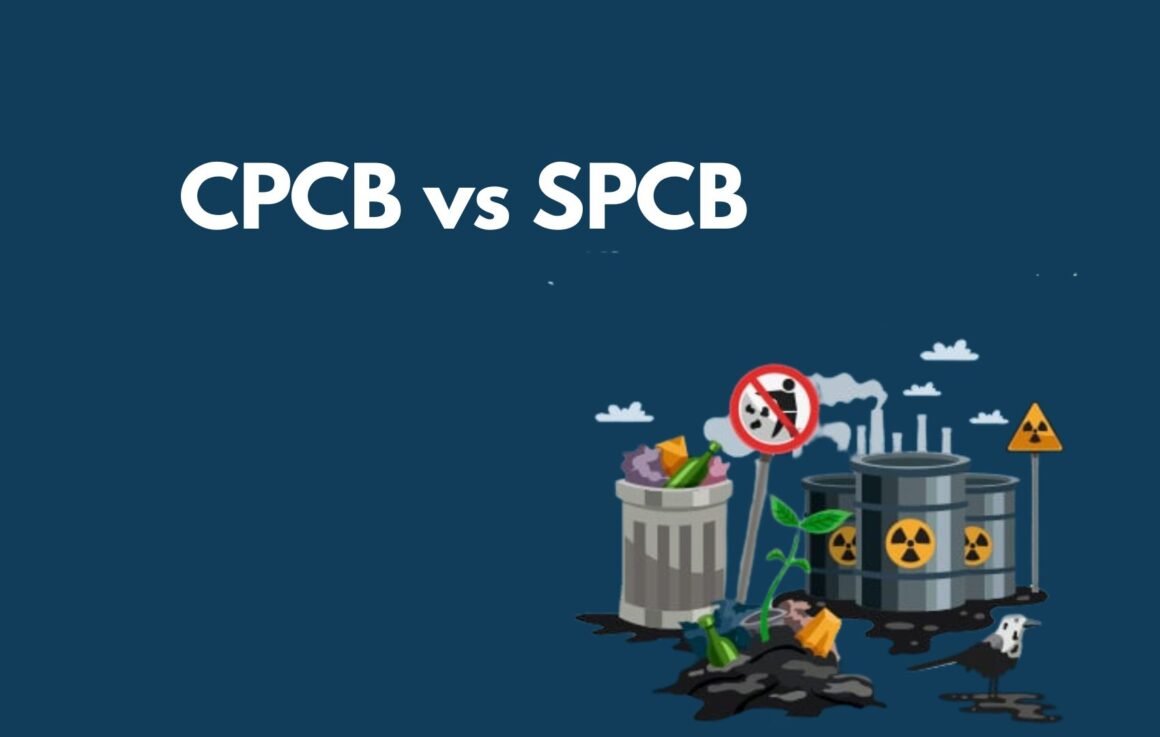
“CPCB vs SPCB — Two Levels, One Mission: Ensuring India’s E-Waste Management Rules Compliance for a Cleaner, Greener Tomorrow!”
With the rapid increase in electronic consumption, India has become one of the world’s largest generators of e-waste. According to the Central Pollution Control Board (CPCB), the country produces over 1.6 million tonnes of electronic waste annually, and this figure is rising.
To manage this growing challenge, the E-Waste (Management) Rules, 2022 were introduced under the Environment (Protection) Act, 1986, laying out the responsibilities of various stakeholders — including manufacturers, producers, recyclers, and refurbishers.
However, a crucial question arises — who ensures that all these entities follow the law? The answer lies with two key regulatory bodies: the Central Pollution Control Board (CPCB) and the State Pollution Control Boards (SPCBs). Both work in coordination to monitor and enforce e-waste compliance across India. Let’s understand how their roles differ and complement each other.
Role of CPCB in E-Waste Compliance
The Central Pollution Control Board (CPCB) functions as the apex authority under the Ministry of Environment, Forest and Climate Change (MoEF&CC). Its responsibilities include policy-making, national monitoring, and enforcement oversight.
Key Functions of CPCB:
- National Registration & Oversight:
- CPCB manages the E-Waste Management Portal, where all producers, recyclers, dismantlers, refurbishers, and manufacturers must register.
- It ensures that only registered entities are part of the formal e-waste management system.
- Formulation of Guidelines:
- CPCB issues detailed technical guidelines for environmentally sound recycling, dismantling, and refurbishment.
- It also sets standards for pollution control, storage, and handling of hazardous waste.
- EPR Target Monitoring:
- CPCB monitors Extended Producer Responsibility (EPR) targets of producers and ensures their compliance through EPR certificates.
- Producers failing to meet EPR targets face Environmental Compensation (EC) as per CPCB’s EC guidelines.
- National-Level Audits and Inspections:
- CPCB conducts audits and surprise inspections of registered facilities to verify adherence to e-waste management standards.
- Issuing Directives:
- CPCB has the power to issue directions to SPCBs or industries in case of violations or policy non-compliance.
- Data Consolidation and Policy Reports:
- CPCB consolidates data from all SPCBs to assess national compliance and provides recommendations to the MoEF&CC for policy improvement.
Role of SPCBs in E-Waste Compliance
While CPCB operates at the national level, State Pollution Control Boards (SPCBs) function as the enforcement authorities at the state level. They ensure that e-waste regulations are properly implemented on the ground.
Key Functions of SPCBs:
- Local Implementation:
- SPCBs issue and renew consents for recycling, dismantling, and refurbishment facilities operating within their jurisdiction.
- On-Site Inspections:
- SPCBs conduct physical inspections of e-waste units to check compliance with environmental and safety norms.
- They also monitor the handling, storage, and disposal of hazardous materials.
- Enforcement and Penalties:
- SPCBs are empowered to take direct action against non-compliant units — including closure, suspension, or penalties.
- Environmental Compensation (EC) Collection:
- While CPCB formulates EC guidelines, SPCBs are responsible for collecting the compensation from violators within their respective states.
- Public Awareness & Education:
- SPCBs organize local awareness campaigns to educate industries, consumers, and informal workers about proper e-waste handling.
- Reporting to CPCB:
- SPCBs submit detailed compliance reports, inspection data, and enforcement statistics to CPCB for national consolidation.
CPCB vs SPCB: Key Differences in Monitoring E-Waste Compliance
| Aspect | CPCB (Central Level) | SPCB (State Level) |
|---|---|---|
| Scope of Work | National policy-making and coordination | State-level implementation and enforcement |
| Registration & Portal | Maintains centralized e-waste registration system | Verifies and validates local applicants |
| Inspection Role | Conducts national-level audits and verifications | Performs on-site inspections and local monitoring |
| EPR Target Oversight | Sets and monitors national EPR targets | Ensures compliance by state producers and recyclers |
| Environmental Compensation (EC) | Frames EC methodology and penalty structure | Collects EC from violators within the state |
| Authority to Direct Action | Can issue national directives to SPCBs and MoEF&CC | Can close or suspend non-compliant facilities locally |
| Public Awareness | National campaigns | Localized awareness drives |
| Reporting Mechanism | Consolidates national compliance data | Submits reports to CPCB |
Coordination Between CPCB and SPCBs
CPCB and SPCBs function in a hierarchical yet collaborative structure. Their effective coordination ensures that e-waste rules are enforced uniformly across India.
Key Coordination Mechanisms:
- CPCB provides policy guidance, while SPCBs handle execution and enforcement.
- SPCBs share data with CPCB through the E-Waste Management Portal, ensuring transparency.
- Joint inspections are conducted for large producers or when violations cross state boundaries.
- CPCB issues advisories or corrective orders when discrepancies arise between state-level reports and national data.
This cooperative framework bridges the gap between policymaking and ground-level implementation.
Challenges in Monitoring E-Waste Compliance
Despite the robust two-tier monitoring system, several challenges persist:
- Informal Recycling Sector Dominance: Nearly 90% of India’s e-waste is processed by unregistered informal workers.
- Resource Constraints: SPCBs face manpower and technical limitations for large-scale monitoring.
- Data Discrepancies: Differences between SPCB and CPCB reports can delay national assessments.
- Low Public Participation: Limited awareness about e-waste collection centers hinders effective monitoring.
To overcome these issues, both CPCB and SPCBs are enhancing digital integration, promoting awareness, and encouraging formalisation of the e-waste recycling sector.
The E-Waste (Management) Rules, 2022 establish a clear framework for monitoring and compliance, with CPCB and SPCBs as its twin pillars. CPCB formulates national policies, manages registrations, and enforces EPR obligations, while SPCBs ensure local implementation, inspection, and enforcement.
Together, they form a robust compliance chain that ensures e-waste is managed scientifically and sustainably. Effective coordination between CPCB and SPCBs is essential for achieving India’s vision of a cleaner, greener, and circular e-waste economy.
FOR MORE BLOGS – beyondthepunchlines.com

 Add to favorites
Add to favorites







